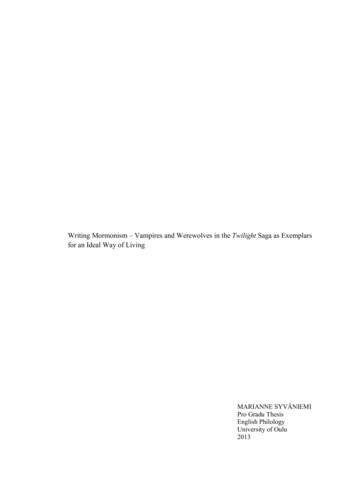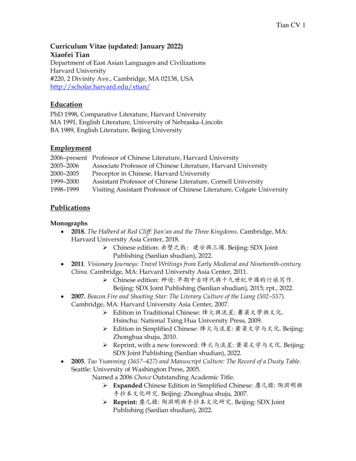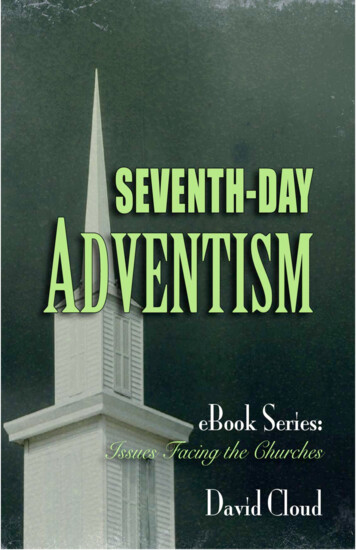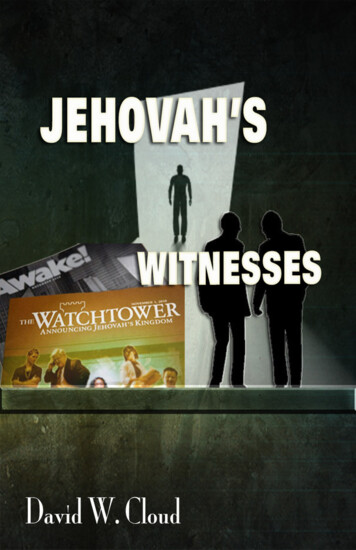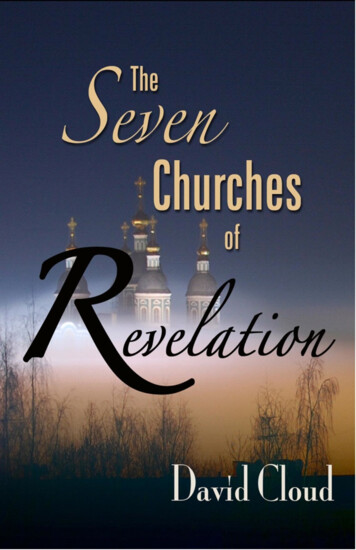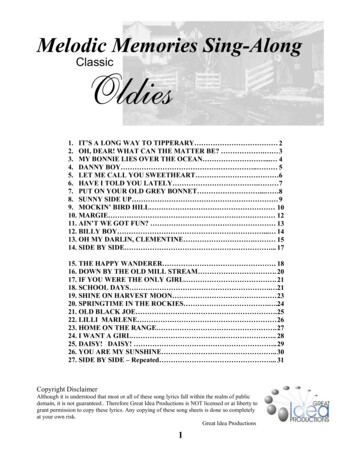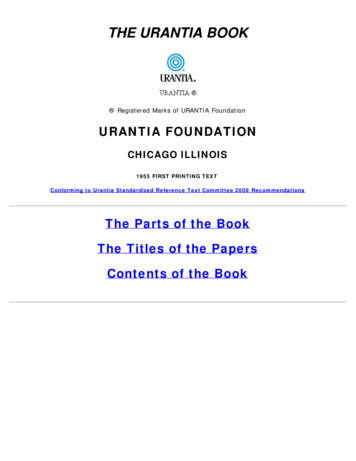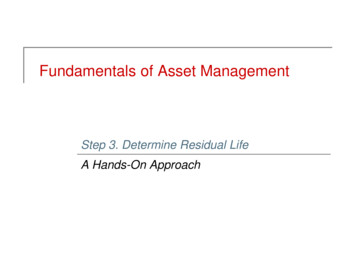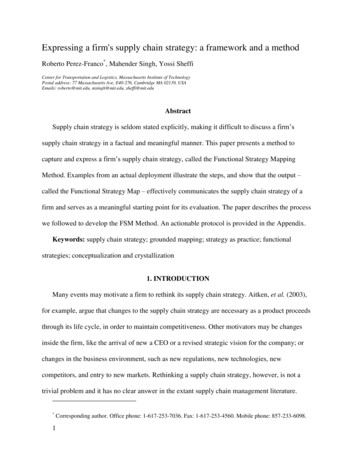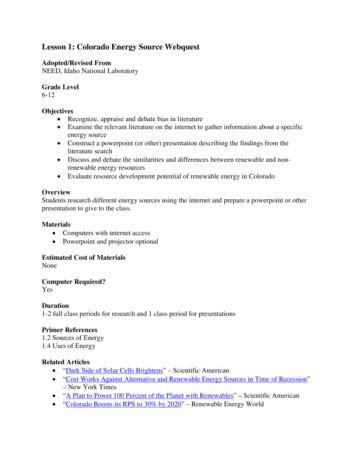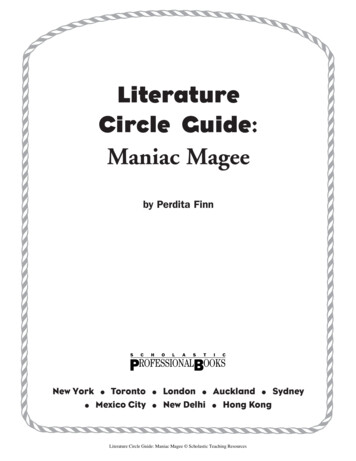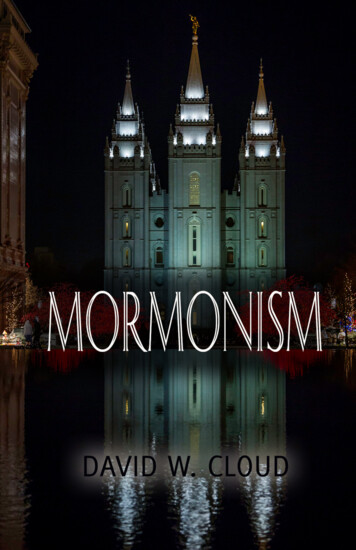
Transcription
MormonismCopyright 2002 by David CloudThis edition November 2014ISBN 978-1-58318-161-4This book is published for free distribution in eBook format.It is available in PDF, Mobi (for Kindle, etc.), and ePubformats from the Way of Life web site. We do not allowdistribution of this book from other web sites.Published by Way of Life LiteraturePO Box 610368, Port Huron, MI 48061866-295-4143 (toll free) - fbns@wayoflife.orgwww.wayoflife.orgCanada: Bethel Baptist Church4212 Campbell St. N., London Ont. N6P 1A6519-652-2619Printed in Canada byBethel Baptist Print Ministryii
Table of ContentsThe Mainstreaming of Mormonism .1Mormonism’s History .2Founded by Joseph Smith .2Reasons for Doubting Smith .3Mormonism’s Growth .17Smith’s Death .19Split into Factions .20Brigham Young.23What the Bible Says .23Current Status.25Missions Work.25Attack Upon Other Denominations .25Mormon Doctrine .27Doctrine about the Bible .27Doctrine about God .28Doctrine about Jesus Christ .30Doctrine of Salvation .34Doctrine about Man .38Doctrine of Polygamy .41About Testing Prophecy .46Miscellaneous .47Evangelicals and Mormons Together .49Evangelical Error .56Should We Dialogue?.59Other Examples of Evangelicals and MormonsTogether.66Way of Life’s eBooks .73Powerful Publications for These Times .74iii
I am thankful for Jerald and Sandra Tanner’sextensive and accurate research into Mormonism.They grew up in the Mormon church and aredescendants of early Mormon leaders. Their bookThe Changing World of Mormonism (MoodyPress, 1981) is available online at their web site.Many excellent materials are available from theirbookstore. [Utah Lighthouse Ministry, P.O. Box1884, Salt Lake City, UT 84110. 801-485-8894,http://www.utlm.org.]iv
The Mainstreaming of MormonismThough Mitt Romney lost the U.S. presidential election in2012, one thing is certain: His candidacy helped pushforward the mainstreaming of Mormonism, which issomething the cult has been aiming for since Mormonleaders voiced their support for Promise Keepers in the1990s.In May 2012, CNN’s Belief Blog published a report on thegrowing influence of Mormons in Washington D.C., statingthat “the nation’s capital has become a Mormon stronghold,with Latter-day Saints playing a big and growing role in theWashington establishment.” The growth of Mormonism inthe nation’s capital was described as “an absolute explosion.”In the last chapter of this book we documentevangelicalism’s increasing friendship with Mormonism.In late October 2012, the Billy Graham EvangelisticAssociation (BGEA) removed a longstanding reference toMormonism as a cult from its web site after Billy andFranklin Graham met with Mitt Romney.We have long said that it is inconsistent and hypocritical toaffiliate with the Roman Catholic Church while rejectingMormonism, as both have a false gospel and a false christ.The “evangelicals and Catholics together” movement shouldnaturally be joined with an “evangelicals and Mormonstogether” movement.The mainstreaming of Mormonism is further evidence thatthe one-world “church” continues to gather steam.1
Mormonism’s HistoryFounded by Joseph SmithThe Mormon church’s official name is the Church of JesusChrist of Latter-day Saints.The following are the highlights of the history of theMormon church as told by its founder:1. Joseph Smith (1805-1844) claimed that in 1820, when hewas 14 years old, he was praying about which denominationwas true and was basing his prayer on James 1:5, when Godthe Father and Jesus Christ appeared to him and informedhim that all existing churches and denominations hadbecome apostate and that “all their creeds were abominationin His sight.” At the time of this alleged divine visitation,Smith was living in Palmyra, New York.2. Smith claimed that about three and a half years later, onSept. 21, 1823, an angel appeared and told him that he had awork for him to do. The angel, named Nephi or Moroni,described to him the location of a book written on goldplates. He also told Smith that with the plates were a pair ofspecial glasses composed of “two stones in silver bows,fastened to a breastplate,” which he called Urim andThummim, and that these would enable him to translate thebook. The angel supposedly said that the plates contained“the fulness of the everlasting gospel.” The plates weresupposed to be located on a hill called Cumorah.3. The angel allegedly appeared to Smith at this hill for fourconsecutive years on the anniversary of the first visit. Finally,on Sept. 22, 1827, Smith obtained the plates and begantranslating the Book of Mormon with the Urim andThummim.4. In May 1829, John the Baptist allegedly appeared toJoseph Smith and his cohort Oliver Cowdery. Johnsupposedly laid hands on them, ordained them to the high2
priesthood of Aaron, baptized them, and charged Smith toestablish the restored church!5. Sometime later that month or the next, in May or June1829, the apostles Peter, James, and John also allegedlyappeared and conferred the Melchizedek priesthood onSmith and Cowdery.6. The Book of Mormon was published in March 1830.7. On April 6, 1830, Joseph Smith and five other menordained themselves elders of the newly established Mormonchurch. They called themselves the Church of Christ at first.The name was later changed to the Church of Jesus Christ ofLatter-day Saints (LDS). Of the first six Mormon elders, mostwere relatives of Joseph Smith.8. By “revelation,” Smith named his wife, Emma, “the ElectLady and Daughter of God.”Reasons for Doubting Smith1. Smith had a very poor reputation in his community.Many testimonies of the citizens were published in the1800s after Smith founded the Mormon church. Thefollowing examples are representative of dozens that werecollected:“I was acquainted with the family of Joseph Smith, Sen.,both before and since they became Mormons, and feelfree to state that not one of the male members of theSmith family were entitled to any credit, whatsoever.They were lazy, intemperate and worthless men, — verymuch addicted to lying. In this they frequently boastedof their skill. Digging for money was their principalemployment. In regard to their Gold Bible speculation,they scarcely ever told two stories alike” (Parley Chase,affirmed before Frederick Smith, Justice of the Peace ofWayne County, Dec. 11, 1833).“These circumstances and many others of a similartenor, embolden me to say that Joseph Smith Jr., is not a3
man of truth and veracity; and that his general character,in this part of the country, is that of an impostor,hypocrite and liar” (Rev. Nathaniel C. Lewis, MethodistEpiscopal Church, affirmed and subscribed, beforeCharles Dimon, Justice of the peace, March 20th, 1834,reprinted by Daniel Kidder, Mormonism and theMormons, 1842)“ Joseph Smith Jr., resided near me for some time afterthis, and I had a good opportunity of becomingacquainted with him, and somewhat acquainted with hisassociates, and I conscientiously believe from the facts Ihave detailed, and from many other circumstances,which I do not deem it necessary to relate, that the whole'Book of Mormon' (so called) is a silly fabrication offalsehood and wickedness, got up for speculation, andwith a design to dupe the credulous and unwary — andin order that its fabricators may live upon the spoils ofthose who swallow the deception” (affidavit of IsaacHale, Joseph Smith’s father-in-law, affirmed to andsubscribed before Charles Dimon, Justice of the peace,March 20th, 1834, reprinted by Daniel Kidder,Mormonism and the Mormons, 1842).2. Prior to writing the Book of Mormon, Smith wasconvicted by a court of law of deceiving people with a “peekstone” that he claimed could locate hidden treasure.On March 20, 1826, Joseph Smith was tried and foundguilty of deceiving people in New York state by claiming hecould find hidden treasure through a peek-stone. He wasconvicted by Justice Albert Neely in Bainbridge, New York.Though this was published in Fraser’s Magazine in 1873,the Mormon church for years claimed that it was not true.In 1971, Wesley P. Walters located the original courtrecords in the basement of a government building inNorwich, New York. These documents prove beyond doubtthat Smith was a convicted “glass looker.” The courtascertained “That at Palmyra he [Smith] pretended to tell bylooking at this stone where coined money was buried in4
Pennsylvania, and while at Palmyra had frequentlyascertained in that way where lost property was of variouskinds ”3. Following is a description of one of Smith’s ventures withhis peek stone:“On a wilderness-hill — now a part of Jacob J. Skinner'sfarm — his peek-stone discovered a ton of silver barswhich had been buried by weary Spaniards as theytrudged up the Susquehanna. An expedition for theirrecovery was undertaken as soon as Smith could musterenough followers to do the work. Unlike St. Paul, Joe didnot work with his own hands, and he did not hesitate tobe chargeable to any one. Several round excavations weremade on the crown of a hill, the largest of which wasabout thirty-five feet in diameter and of about the samedepth. The water was drained toward the south, and ashanty covered the hole from the eyes of the scoffers andthe profane. The diggers had proceeded with great labor,and were just ready to grasp the silver, when the charmmoved it three hundred feet to the north-east. Joetracked it with his peek-stone to its hiding-place. It wasnot so far under the surface this time — only abouttwenty feet — and the faithful again worked with a will. the silver again flitted away, and alighted fifty feetbeyond the big hole. They determined to capture it ifthey ran the hill through a sieve. The third hole had beensunk fifteen out of the necessary twenty feet when thetreasure once more jumped to the other side of the bighole. Then the prophet had a vision: the blood of a blacksheep must be shed and sprinkled around the diggings.Black sheep were scarce, and while they waited for onethe faithful obtained their needed rest. At length, nosheep appearing, Joe said that a black dog might answer.A dog, therefore, was killed, and the blood was sprinkledon the ground. After that the silver never went far away.Still, it waltzed about the big hole in such a lively mannerthat frequent tunnelling to effect its capture availednothing. At last the prophet decided that it was of no use5
to dig unless one of their number was made a sacrifice.None of the faithful responded to his call, and thus themagnificent scheme was abandoned. Oliver Harper, oneof the diggers who furnished the money, was soonafterward murdered. The prophet thought this mightanswer for a sacrifice: he again rallied the diggers, butthe charm remained stubborn and would not reveal thesilver” (Frederic Mather, “Early Days of Mormonism,”Lippincott’s Magazine, August 1880).4. Smith used the same peek-stone to translate the Book ofMormon.Smith claimed that after he translated the first 116 pagesusing the so-called Urim and Thummim, his friend MartinHarris lost the manuscript. In reality, Harris’s wife had takenthe manuscript and hid it or burned it, because she did notwant her husband to continue giving money to Smith(Mather, “Early Days of Mormonism”).After that, by his own testimony, Smith continued thetranslation with the aid of his peek-stone. He would put thestone in his tall white stovepipe hat, then put the hat over hisface and allegedly read the words off to his scribe. In this wayhe produced The Book of Mormon. It was exactly the samemethod that he had previously used to magically seek thelocation of hidden treasure.Consider the following testimony of Smith’s father-in-law,Isaac Hale:“I first became acquainted with Joseph Smith, Jr. inNovember, 1825. He was at that time in the employ of aset of men who were called ‘money-diggers;’ and hisoccupation was that of seeing, or pretending to see bymeans of a stone placed in his hat, and his hat closedover his face. In this way he pretended to discoverminerals and hidden treasures. . Smith, and his father,with several other ‘money-diggers’ boarded at myhouse. . Young Smith gave the ‘money-diggers’ greatencouragement, at first, but when they had arrived in6
digging, to near the place where he had stated animmense treasure would be found—he said theenchantment was so powerful that he could not see. .After these occurrences, young Smith made several visitsat my house, . and WHILE I WAS ABSENT FROMHOME, CARRIED OFF MY DAUGHTER, INTO THESTATE OF NEW YORK, WHERE THEY WEREMARRIED WITHOUT MY APPROBATION ORCONSENT. . In a short time they returned . Smithstated to me, that he had given up what he called ‘glasslooking,’ and that he expected to work hard for aliving. . He also made arrangements with my son AlvaHale, to go up to Palmyra, and move his (Smith’s)furniture &c. to this place. . Soon after this, I wasinformed they had brought a wonderful book of Platesdown with them. . THE MANNER IN WHICH HEPRETENDED TO READ AND INTERPRET, WAS THESAME AS WHEN HE LOOKED FOR THE MONEYDIGGERS, WITH THE STONE IN HIS HAT, AND HISHAT OVER HIS FACE, WHILE THE BOOK OFPLATES WERE AT THE SAME TIME HID IN THEWOODS!” (affidavit of Isaac Hale, affirmed to andsubscribed before Charles Dimon, Justice of the peace,March 20th, 1834, reprinted by Daniel Kidder,Mormonism and the Mormons, 1842).David Whitmer, one of Smith’s witnesses, also testified thatSmith translated the Book of Mormon with his peek stone:“I will now give you a description of the manner inwhich the Book of Mormon was translated. Josephwould put the seer stone into a hat, and put his face inthe hat, drawing it closely around his face to exclude thelight; and in the darkness the spiritual light would shine.A piece of something resembling parchment wouldappear, and on that appeared the writing” (An AddressTo All Believers In Christ, by David Whitmer, p. 12,quoted by the Tanners).7
Joseph Smith’s wife, Emma, testified the same thing to herson. In fact, Emma said in a letter written March 27, 1876,that the entire Book of Mormon was translated by the use ofa stone.“In writing for your father I frequently wrote day afterday, after sitting by the table close by him, he sitting withhis face buried in his hat, with the stone in it, anddictating hour after hour with nothing betweenus” (Emma Smith, The Saints’ Herald, May 19, 1888, p.310).5. Smith’s peek-stone or “seer stone” has been seen andacknowledged by Mormon authorities.Early Mormon church leader Orson Pratt testified ofSmith’s peek stone: “ sometimes Joseph used a seer stonewhen enquiring of the Lord, and receivingrevelation” (“Report of Elders Orson Pratt and Joseph F.Smith, Concluded,” Deseret Evening News, 23 Nov, 1878).Brigham Young showed the stone to the regents of theUniversity of the State of Deseret (later named University ofUtah) on February 25, 1856. One of the regents, Hosea Stout,described it in his journal as “a silecious granite dark coloralmost black with light colored stripes somewhat resemblingpetrified poplar or cotton wood bark about the size butnot the shape of a hen's egg” (Stout Diary, February 25, 1856).In 1887, a bodyguard of church president John Taylorreported that he had seen and handled the seer stone: “OnSunday last I saw and handled the seer stone that the ProphetJoseph Smith had. It was a dark color, not round on one side.It was shaped like the top of a baby's shoe, one end like thetoe of the shoe, and the other round” (Samuel Bateman diary,August 17, 1887, Lee library).In 1888, fifth Mormon President Wilford Woodruff placedthe stone on the altar of the Mormon temple in Manti, Utah.“Before leaving I Consecrated upon the Altar the seers Stonethat Joseph Smith found by Revelation some 30 feet under8
the Earth [and] Carried By him through life” (WilfordWoodruff's journal, May 18, 1888)Mormon Bishop Fredrick Kesler wrote in his diary in 1899that President Lorenzo Snow showed him the peek stone: “.showed me the Seerers Stone that the Prophet Joseph Smithhad by which he done some of the Translating of the Book ofMormon with. I handeled it with my own hands. I felt asthough I see & was handling a very Sacred thing. I trust &feel that it will work in his hands as it did in the ProphetJoseph Smiths hands” (Fredrick Kesler diary, February 1,1899, Marriott Library).Sixth Mormon President Joseph Fielding Smith confirmedthat the seer stone is in the possession of the Mormonchurch: “The statement has been made that the Urim andThummim was on the altar in the Manti Temple when thatbuilding was dedicated. The Urim and Thummim so spokenof, however, was the seer stone which was in the possessionof the Prophet Joseph Smith in early days. This seer stone isnow in the possession of the Church” (Doctrines of Salvation,vol. 3, p. 225).In the early 1980s, Mary Brown Firmage (a descendent ofBrigham Young) was allowed to see the seer stone. Shereported: “The stone was not chocolate brown but rather thecolor of brown sugar. It was 3-4 inches long, 2 inches wide,and had a hump in the middle which made it perhaps 2inches thick at the thickest point. It was flat on the bottomand had three black, concentric circles on the top 1/2 inch.Below the circles were many small black circles. The stonewas not transparent” (Mary Brown Firmage interview withRichard Von Wagoner, Aug. 11, 1986; Von Wagoner papers,Marriott Library).5. The 11 witnesses who claimed to have seen the goldenplates are highly suspect.Three were from Smith’s own family (including his fatherand brother), which had a poor reputation in theircommunity and which had a motive to support Joseph’s9
religious views. Together with Joseph, his father and brotherwere involved in treasure searching with divining rods andseer stones.Oliver Cowdery and Martin Harris used divining rods tosearch for hidden treasure. (This was admitted by D. MichaelQuinn, Mormon writer, in Brigham Young University Studies,Fall 1978, p. 82.)Cowdery, Harris, and David and John Whitmer wereforced to leave the Mormons in 1838 when they had settledin Missouri. They were charged by Joseph Smith with beingevil men, and they, in turn, charged Smith and the Mormonsof great wickedness. For example, in a letter dated December16, 1838, Joseph Smith said that “John Whitmer, DavidWhitmer, Oliver Cowdery, and Martin Harris are too meanto mention” (History of the Church, vol. 3, p. 232). They werecharged with being “counterfeiters, thieves, liars, andblacklegs of the deepest dye.”Hiram Page had his own peek-stone by which he gave“revelations.”The witnesses had a reputation of being gullible and someof jumping from one religious movement to another. Forexample, Martin Harris was first a “Quaker, then aUniversalist, next a Restorationer, then a Baptist, next aPresbyterian, and then a Mormon” (E.D. Howe, MormonismUnveiled, 1834, pp. 260-61, cited by the Tanners). After thathe was a Shaker and then a Strangite! Altogether, Harrischanged his religious convictions at least 13 times.Hiram Page, David and John Whitmer, Martin Harris, andOliver Cowdery were also witnesses for a man named JamesJesse Strang, who claimed that he, too, had translated plateswith Urim and Thummim. He started his own movement,and Harris went to England on a mission for the Strangites.6. The accounts in the Book of Mormon have proven to beuntrue.10
It contains what is purported to be the account of anancient civilization in America that descended from theHebrews and to which Jesus Christ appeared after Hisresurrection.“The two main groups in the Book of Mormon are theNephites and Lamanites. The story tells of a family groupled by an Israelite prophet named Lehi. He is warned byGod to flee Jerusalem at 600 B.C. He and his familymake their way to the southern part of Arabia wherethey build a ship to sail across the Pacific Ocean toAmerica. Two of his sons, Nephi and Laman struggle forleadership. This leads to the division of the group intotwo warring factions, the Nephites (usually the goodguys) and Lamanites (usually the bad guys). The lastbattle between the two groups, in 421 AD, wipes outalmost all of the Nephites. Moroni, the last survivingNephite, buries the records of his civilization in the hillCumorah. Hundreds of years later, Joseph Smith isdirected to the spot by Moroni (some records sayNephi), now a resurrected being who has become anangel” (Tanner, “Book of Mormon Overview”).Testimony of the National Geographic Society: In a letterdated January 11, 1990, the Research Correspondent for theNational Geographic Society testified: “The Society has neverused the Book of Mormon to locate archaeological sites, andwe do not believe that any of the places named in the Book ofMormon can be placed geographically by the evidence ofarchaeology. So far as we know there is no archaeologicalevidence to verify the history of early peoples of the WesternHemisphere as presented in the Book of Mormon.”Testimony of the Smithsonian Institute: In 1996, theDepartment of Anthropology of the Smithsonian Institute,Washington, D.C., issued a similar letter: “The Book ofMormon is a religious document and not a scientific guide.The Smithsonian Institution has never used it inarcheological research and any information that you have11
received to the contrary is incorrect. Smithsonianarcheologists see no direct connection between thearcheology of the New World and the subject matter of thebook.”Many of the things mentioned in the Book of Mormonwere not in North America at that time: “The Book ofMormon mentions: wheat (Mosiah 9:9), horses (1 Nephi18:25), chariots (Alma 18:9-11; 20:6; 3 Nephi 3:22), cows(Enos 21), elephants (Ether 9:19), silk (Alma 1:29; 4:6; Ether9:17), linen (Mosiah 10:5; Helamon 6:13; Ether 10:24),money-pieces of gold and silver (Alma 11:3-20), steel (2Nephi 5:15; Jarom 1:8; Ether 7:9). None of these items werehere before the Spaniards [in the 15th century]” (Tanner).7. Joseph Smith was a braggart.“Come on! ye prosecutors! ye false swearers! All hell,boil over! Ye burning mountains, roll down your lava!for I will come out on top at last. I have more to boast ofthan ever any man had. I am the only man that has everbeen able to keep a whole church together since the daysof Adam. A large majority of the whole have stood byme. Neither Paul, John, Peter, nor Jesus ever did it. Iboast that no man ever did such a work as I. Thefollowers of Jesus ran away from Him; but the Latter-daySaints never ran away from me yet . When they can getrid of me, the devil will also go” (Joseph Smith, sermon,Sunday, May 26, 1844, Nauvoo, Missouri, History of theChurch, vol. 6, p. 408, 409).“But I am learned, and know more than all the world puttogether. The Holy Ghost does, anyhow, and he is withinme, and comprehends more than all the world; and I willassociate myself with him. I have now preached alittle Latin, a little Hebrew, Greek, and German; and Ihave fulfilled all” (Smith, April 7, 1844, History of theChurch, vol. 6, pp. 302-317).“I have got all the truth which the Christian worldpossessed, and an independent revelation in the bargain,12
and God will bear me off triumphant” (Joseph Smith,June 16, 1844, History of the Church, vol. 6, pp. 473-479,emphasis added).8. Smith carried a magic talisman.When Joseph Smith was shot to death, he had in his pocketa magic charm representative of the pagan god Jupiter. Thiswas documented in 1974 by Dr. Reed Durham, director ofthe LDS Institute of Religion at the University of Utah. Hegave the evidence in a speech before the Mormon HistoryAssociation on April 20, 1974.Durham testified that the talisman carried by Smith, whichis the shape of a silver dollar, was described in a magic bookprinted in England in 1801.Jupiter was the Greek god Zeus.The occultic talisman was used to gain “riches, favor,power, love and peace” as well as to gain the affection ofwomen. That certainly sounds like the type of talisman thatJoseph Smith would carry!9. Smith was a liar and an adulterer.In a sermon on Sunday, May 26, 1844, Smith testified thathe had only one wife, whereas in reality he had dozens!Consider what he said: “What a thing it is for a man to beaccused of committing adultery, and having seven wives,when I can only find one” (Joseph Smith, May 1844).In reality, Smith had privately proclaimed to his innercircle that previous marriages were null and void and thatpreviously married women were free to take new marriages.Smith himself had some 48 or so wives and several otherMormon leaders also had contracted multiple new wives.10. Smith’s claim to be able to perform miracles was bogus.Example: “He did, however, announce that on a certainevening, about twilight, he would walk on the water. Theplace of his selection was watched by Gentile boys until oneof Smith’s followers was seen to construct a bridge of planksjust under the surface. Watching their opportunity, the boys13
removed the outer planks. Before the prophet made theattempt to walk he exhorted his followers to have strong faith.When his bridge suddenly gave way he swam ashore andsaid, ‘Woe unto you of little faith! Your faith would not holdme up’” (Frederic Mather, “The Early Days of Mormonism,”Lippincott’s Magazine, August 1880).Example: “However much he might fail in discoveringmaterial treasures, Smith’s hold upon the religious infatuationof his followers grew more and more strong. John Morse, anaged convert to Mormonism, had recently died, and Smithwas sent for to restore him to life. After looking at him Smithdeclined, because it would be a pity to have him sufferrheumatism and die again so soon! This was something likeBrigham Young’s refusal to restore a lost leg to one of hisMormons, on the ground that if he did it the man would beobliged to walk on three legs all through eternity!” (Mather,“The Early Days of Mormonism”).11. Smith’s claim to be able to read ancient languages wasbogus.“That the prophet was not well advanced either in Greekor English appears from a story related by the Rev.Henry Caswall, who visited Nauvoo, Illinois, in 1842. Hehad with him a copy of the Psalter in Greek, which hehanded to the prophet and asked him to explain itscontents. Smith looked at it a few moments, and thenreplied, ‘No, it ain’t Greek at all, except perhaps a fewwords. What ain’t Greek is Egyptian, and what ain’tEgyptian is Greek. This book is very valuable: it is adictionary of Egyptian hieroglyphics.’ Pointing to thecapital letters at the beginning of each verse, he said,‘Them figures is Egyptian hieroglyphics, and them whichfollows is the interpretation of the hieroglyphics, writtenin the reformed Egyptian. Them characters is like theletters that was engraved on the golden plates.’ Upon thisthe Mormons began to congratulate Mr. Caswall on theinformation he was receiving. ‘There!’ they said, ‘we toldyou so: we told you that our prophet would give you14
satisfaction. None but our prophet can explain thesemysteries.’ The prophet then attempted to buy the book,on the ground that it could be of no use to Caswall,because he did not understand it” (Frederic Mather,“The Early Days of Mormonism,” Lippincott’s Magazine,August 1880).12. The Book of Abraham DeceptionIn 1835, Smith claimed that he had translated a papyruswritten by Abraham some 4,000 years ago. Titled “The Bookof Abraham,” it was accepted by the Mormon church asscripture and was published as part of the Pearl of Great Price.Long thought to have been lost in the Chicago fire of 1871,Smith’s collection of papyri was discovered by theMetropolitan Museum of Art and returned to the Mormonchurch on November 27, 1967.An examination by linguists proved that Smith’s“translation” was bogus. His “translation” of less than fourlines from the papyrus became 49 verses of more than 2,000words in English!“When Egyptologists translated this piece of papyrus,they found that it contained absolutely nothingconcerning Abraham. Instead, it turned out to be apagan funerary text known as the ‘Book of Breathings,’ awork which actually evolved from the Egyptian Book ofthe Dead. The Book of Breathings did not come intoexistence until the later stages of Egyptian history — justa few centuries before the time of Christ. Like the Bookof the Dead, it was buried with those who died in ancientEgypt. It is filled with magic and pagan gods. It wasobviously written by a very superstitious people, and isquite different from the religion taught in the Bible. Thefact that the papyrus Joseph Smith used as the basis forhis Book of Abraham is in reality the Book of Breathingscannot be disputed because the name ‘Book ofBreathings’ appears clearly on the fourth line of thefragment. In 1968 two Egyptologists from the Universityof Chicago's Oriental Institute, Professors John A.15
Wilson and Klaus Baer, identified the papyrus as the‘Book of Breathings.’ The papyrus says, “After (his) twoarms are [fast]ened to his breast, one wraps the Book ofBreathings, which is with writing both inside andoutside of it,
6. !e Book of Mormon was published in March 1830. 7. On April 6, 1830, Joseph Smith and &ve other men ordained themselves elders of the newly established Mormon church. !ey called themselves the Church of Christ at &rst. !e name was later changed to the Church of Jesus Christ of Latter-day Saints (LDS).
